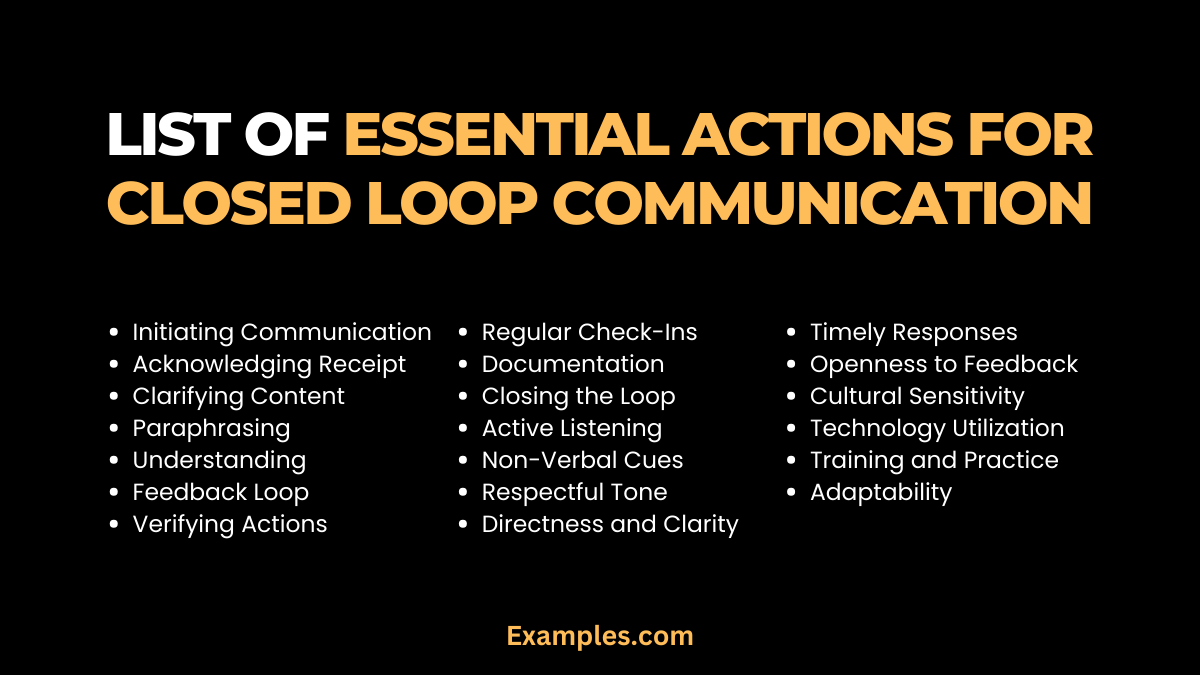19+ Essential Actions for Closed Loop Communication Examples
Essential Actions for Closed Loop Communication: A Comprehensive Guide – This guide delves into the critical actions necessary for effective Closed Loop Communication. By incorporating real-world communication examples, we provide a clear understanding of how this method enhances clarity and ensures message accuracy in various settings, including healthcare and team management. Discover the pivotal steps and benefits, and learn how to apply these techniques to facilitate better, more efficient communication in professional environments.
What are Essential Actions for Closed Loop Communication?
Essential actions for Closed Loop Communication are specific steps taken to ensure clear and accurate exchange of information, especially in high-stakes environments like healthcare or aviation. These actions typically include:
- Initiating the Message: The communication starts with the sender clearly conveying the information or instruction. This step involves articulating the message in a clear, concise, and unambiguous manner.
- Acknowledgement: The receiver acknowledges the message, indicating that they have received it. This acknowledgment is crucial as it signifies that the message has reached the intended party.
- Verification: The receiver then repeats or paraphrases the message. This step is essential for clarity, as it ensures that the receiver has correctly understood the message as intended by the sender.
- Confirmation: Finally, the sender confirms the accuracy of the receiver’s understanding. If there are any discrepancies or misunderstandings, the sender clarifies or corrects them at this stage.
These steps collectively form a cycle that helps in preventing misunderstandings and ensuring clarity in communication. Closed Loop Communication is particularly effective in high-stakes environments like healthcare, aviation, and team-based projects, where precise and accurate communication is critical. It’s a method that reinforces the importance of both speaking and listening in effective communication.
For more detailed information about Closed Loop Communication, you might find these resources useful:
Essential Actions for Closed Loop Communication Bundle
Download Now in PDF20 List of Essential Actions for Closed Loop Communication

Closed Loop Communication is integral in maintaining clarity and preventing misunderstandings, especially in high-stakes environments like healthcare and aviation. Here are ten examples that illustrate the steps and ways to use this communication method effectively:
- Initiating Communication: This involves starting a conversation with a precise and clear message, ensuring that the intent of the communication is straightforward and understandable.
- Acknowledging Receipt: The receiver of the message acknowledges hearing the message, which is crucial in confirming that the communication process has begun.
- Clarifying Content: If any part of the message is unclear, the receiver should ask questions to gain a better understanding.
- Restating or Paraphrasing: The receiver repeats the message in their own words, ensuring they have correctly interpreted the message.
- Confirming Understanding: The sender of the message confirms that the receiver’s interpretation of the message is accurate.
- Feedback Loop: This involves ongoing communication to modify or update the original message as needed, ensuring that both parties remain on the same page.
- Verifying Actions: Confirming that the actions being taken are in direct response to the communicated instructions is key in preventing misunderstandings.
- Regular Check-Ins: Especially important in long-term projects or situations, periodically confirming understanding ensures continued alignment and clarity.
- Documentation: Keeping a record of key communication points helps in maintaining clarity and serves as a reference for future discussions or actions.
- Closing the Loop: Once the communication objective is achieved or the issue resolved, concluding the communication cycle signifies a complete and successful exchange.
- Active Listening: Active participation in the communication process is crucial, focusing on understanding the message in its entirety.
- Non-Verbal Cues: Observing body language and tone is important, as they can significantly impact how the message is interpreted.
- Respectful Tone: Maintaining professionalism and respect throughout the communication helps in fostering a positive exchange.
- Directness and Clarity: Clear, straightforward communication prevents ambiguities, ensuring the message is easily understood.
- Timely Responses: Prompt responses are essential in maintaining the flow of communication and avoiding delays.
- Openness to Feedback: Being receptive to additional insights, questions, or clarifications enriches the communication process.
- Cultural Sensitivity: Awareness of cultural differences is crucial in tailoring communication to be effective across diverse groups.
- Technology Utilization: Leveraging communication technologies can enhance the effectiveness and reach of the communication process.
- Training and Practice: Regular skill development in communication can significantly improve the efficacy of interactions.
- Adaptability: Flexibility in communication styles to suit different situations or audiences is key to effective communication.
What are the Steps for Closed Loop Communication?
Closed Loop Communication is a structured approach to ensure clear and effective communication, especially crucial in high-risk environments like healthcare and aviation. Here’s how to use Closed Loop Communication frequently and effectively:
- Initiate Clear Messaging: Start with a precise and direct message. For example, a healthcare provider might say, “Please prepare 10mg of Medication A for Patient B.” This initial step is crucial in settings like Closed Loop Communication in Medical where accuracy can be a matter of life and death.
- Seek Acknowledgment: The receiver of the message should acknowledge that they have heard and understood the message. They might repeat, “Preparing 10mg of Medication A for Patient B.”
- Confirm Understanding: The sender then confirms or corrects the receiver’s acknowledgment. This step is essential to ensure no part of the message is misinterpreted.
- Provide Feedback: If there’s any part of the message that is not clear, the receiver should ask for clarification, and the sender should provide additional information or rephrase for better understanding.
- Make it a Habit: Incorporate Closed Loop Communication into daily routines, particularly in environments where clear communication is vital. Regular practice will embed this method in the organizational culture.
- Training and Reinforcement: Conduct regular training sessions to reinforce the importance and techniques of Closed Loop Communication. This is particularly important in contexts where the stakes are high, such as in Closed Loop Communication in Medical environments.
- Open Loop vs Closed Loop Communication: Understanding the difference between these two forms of communication is key. While Open Loop Communication involves one-way communication without seeking confirmation, Closed Loop Communication ensures a two-way process with confirmation and clarification, which is more effective in preventing miscommunication.
By applying these steps consistently, Closed Loop Communication can become an integral part of daily communication processes, leading to improved accuracy and efficiency in information exchange, especially in critical settings like healthcare.
What is the Closed-Loop Process?
The closed-loop process involves sending a message, receiving feedback, and confirming understanding to ensure accurate communication.
What are the Essential Elements of a Closed Loop System?
Essential elements include clear messaging, acknowledgment of receipt, confirmation of understanding, and feedback to clarify misunderstandings.
How Does Closed-Loop Communication Work?
Closed-loop communication works by sending a message, receiving its acknowledgment, verifying understanding, and then clarifying or reiterating as needed for complete accuracy.
Statistics Highlighting the Essential Actions for Closed Loop Communication
To effectively implement and understand the essential actions for Closed Loop Communication, it’s important to consider several aspects based on the insights gained from authoritative sources:
- Understanding Closed Loop Communication: Closed Loop Communication is a structured communication technique that ensures messages are correctly understood by recipients. It typically involves methods like call-outs, check-backs, and teach-backs. This approach is particularly significant in healthcare settings to alleviate risks of adverse events caused by communication breakdowns????.
- Implementing in Healthcare: In healthcare settings, closed-loop communication can decrease misconceptions and misunderstandings between nursing and medical teams, reducing the risk of medical errors. Utilizing this method can involve structured interdisciplinary bedside rounding approaches, team huddle approaches, and training in simulation-based closed-loop communication????.
- Enhancing Patient Safety: The practice of closed-loop communication is integral in enhancing patient safety. Through effective communication practices, such as continuous and transparent decision-making, healthcare providers can significantly improve the safety and quality of care. During the COVID-19 pandemic, the healthcare workforce adapted its communication strategies to respond to dynamic and challenging environments, which included broad inclusion of interdisciplinary teams and expanded use of telemedicine??.
- Integration with Health Information Technology (HIT): HIT can support structured communication processes among providers. For example, structured note templates in Electronic Health Records (EHR) and automated abstraction of data can facilitate communication. However, it’s crucial to balance the use of HIT with essential oral communication, avoiding over-reliance on electronic asynchronous communication??.
- Lessons from COVID-19: The COVID-19 pandemic highlighted the need for innovative communication practices. Examples include continuous communication with the workforce using all communication modalities and distance communication facilitated by technology, enabling more seamless integration into everyday operations like rounding and huddles??.
- Future Research and Development: Moving forward, there is a need for better tools and approaches for communicating medication safety with patients and effective transition tools that align with legal requirements. Research is also needed to better understand communication approaches applied during the pandemic and test them as part of usual care??.
Closed-loop communication significantly enhances task completion speed and efficiency, particularly in pediatric trauma resuscitation. This technique not only prevents medical errors but also fosters a more effective healthcare environment. Emphasizing closed-loop communication in trauma team leader training and incorporating it into trauma drills can greatly improve patient care outcomes



